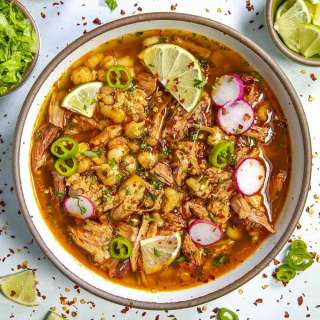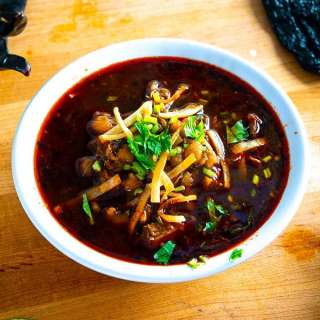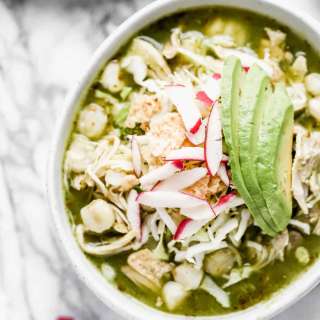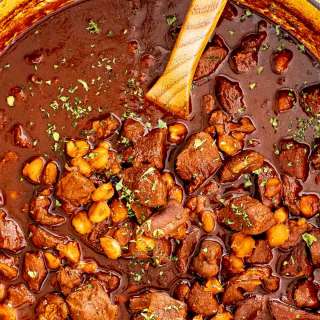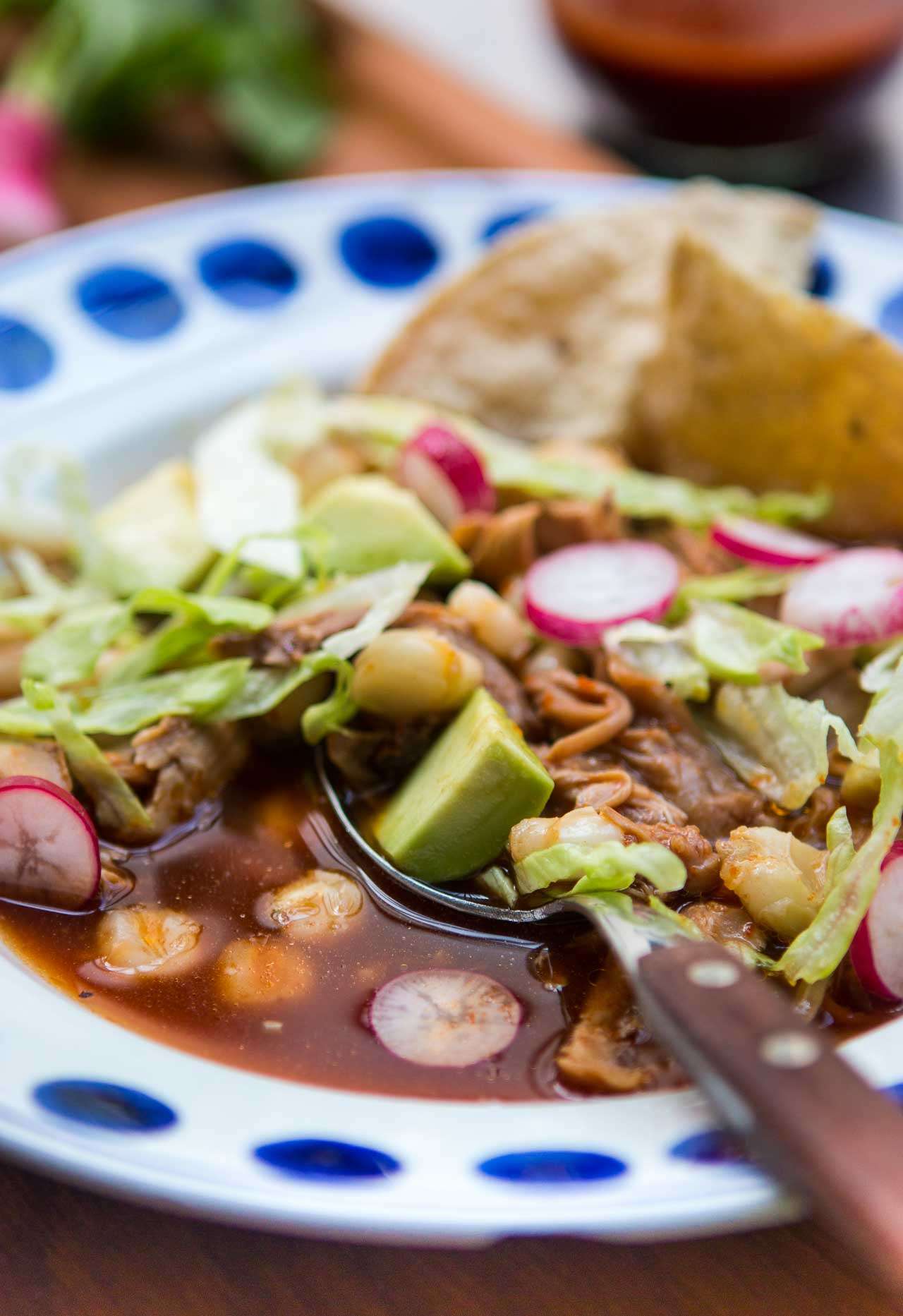
Red Chile Pozole
User Reviews
0.0

Red Chile Pozole
Adapted from The Rancho Gordo Pozole Book by Steve Sando This pozole isn't especially spicy but if you want to add some zip, the optional salsa at the end of the recipe, made with árbol dried chiles, will definitely do the trick. The árbol chile salsa is very spicy (and pleasantly smokey) but you might want to notify guests not used to eating hot sauce that a little goes a long way. The original recipe in Steve's book had two chicken feet, chopped, and a chicken back added to enrich the broth. None of the butchers near me had them, so I went with a split pig's foot to give the soup extra body. You can use either the chicken or pig parts, or skip them. Of course, if serving people that don't eat pork, omit the pig's foot. To prepare the hominy, follow the instructions on the package. If using dried hominy, you'll need to soak it for at least 6 hours or overnight. If you use canned hominy, drain it well and discard the liquid. To serve, offer an array of accompaniments alongside, so people can customize their own bowl of pozole. Sliced radishes, thinly sliced iceberg lettuce or white cabbage, ripe avocado cubes, dried Mexican oregano, finely-chopped white onion, crisp tortilla chips or strips (or chicharrones), chopped cilantro, and cotija cheese, are good garnishes, and definitely provide wedges of fresh lime for people to squeeze the juice into their soup.
Ingredients
For the red chile paste
- 2 cups (500ml) water
- 2 ancho chiles wiped clean, stemmed and seeded
- 3 guajillo chiles wiped clean, stemmed and seeded
- 1/2 medium onion peeled and diced
- 6 cloves garlic peeled and sliced
For the soup
- 4 chicken thighs
- 4 chicken legs
- 1 pig's foot, split lengthwise or two chicken feet, chopped, and one chicken back (optional)
- 1/2 onion peeled and diced
- 3 cloves garlic peeled and sliced
- 2 bay leaves
- 3 black peppercorns cracked
- 1 tablespoon Kosher or sea salt (if using Morton kosher salt, use 2 teaspoons)
- 8-10 cups (2l) water
- 5-6 cups (875g-1kg) prepared (cooked) hominy drained (if making it yourself, save the cooking liquid)
Instructions
- To make the red chile paste, heat 2 cups (500ml) of water in a saucepan. Remove from heat, cover, and set aside. Cut the dried chiles in half. Heat a heavy-duty skillet over medium heat. Toast the chiles in the skillet, turning them frequently, until fragrant, which will take just a minute or two, depending on how hot the skillet is. (Don't let them burn.) Place the chiles in the saucepan of warm water, cover, and let stand 15 minutes.
- Put the chiles in a blender, reserving the liquid, and puree the chiles with the onion and garlic, adding just enough of the reserved liquid to allow the blades of the blender to puree the mixture, scraping down the sides as needed. (I added about 1/2 cup/125ml of the liquid.) Pass the chile puree through a mesh strainer using a flexible spatula, into a bowl, discarding the skins and any errant seeds. Set aside. (The red chile paste can be made in advance, and either refrigerated for several days or frozen.)
- To make the soup, put the chicken and pig's foot or chicken feet and back (if using) into a large pot along with the chopped onion, garlic, bay leaves, black peppercorns, and salt. Add 8 to 10 cups water, just enough to just cover the chicken. Bring to a boil, then reduce heat to a steady simmer, partially cover, and let cook for 1 hour.
- When the chicken has finished cooking, remove the legs and thighs to a plate. Strain the stock through a mesh sieve into a large bowl and chill thoroughly, preferably overnight. When the chicken is cool enough to handle, remove the skin from the chicken and shred the meat into a bowl. Refrigerator the chicken until ready to use.
- To finish the soup, skim the fat off the surface of the stock. Put the red chile paste in Dutch oven or large soup or stockpot*. Gradually whisk in 6 cups (1,4l) of the stock, then add the chicken meat and hominy. (You can start with the smaller amount of hominy, and add more if you want the soup thicker.) Bring the soup to a near boil. Once hot, taste and add additional salt, if desired. If the soup is too thick, you can add reserved hominy cooking liquid or additional stock.
Notes
- Notes
- Notes
- *The original recipe said to heat 1-2 tablespoons of oil or lard and cook the chile paste down before adding the broth. As you can see from the 5th photo in the post, mine was already quite thick so it didn't need to be cooked down. If yours is very liquidy, you may wish to.
- I'm frequently asked about where to get fresh tortillas in France. In Paris, unfortunately, the place that made fresh tortillas closed down, but you can get Mexican products at Bocamexa and Latino Market. Mail order Mexican ingredients, such as tortillas, hominy, and dried chiles are available in France from Casamex, Los Juanitos, and Mi Tiendita. If you're in the U.S., top-quality dried hominy is available from Rancho Gordo, which is what I used, which I brought back.
- As for the fiery chile de árbol salsa, if you want to make to accompany the pozole, I made Steve's recipe from his book as a condiment. (You can see the photos of the smaller árbol chiles, being fired up in a skillet, in the post.) The salsa is incredibly spicy but does add a pleasant smokiness in addition to packing a punch. Be sure to make it in a well-ventilated place and don't inhale deeply when you open the blender! (Take it from me...)
- The salsa is made by lightly toasting 1 cup (25g) of dried árbol chiles in a dry skillet. Place the toasted chiles in a bowl with 1/2 cup (125ml) pineapple or apple cider vinegar and the juice of 4 limes. Let hydrate for at least 15 minutes. (Mine didn't quite hydrate as well as they usually do in warm water, so you may want to warm the vinegar a bit first, or after adding the chiles if they need further softening.) Blend the chiles with 1 teaspoon ground cumin, a pinch of salt, and 2 cloves of peeled garlic in a blender with just enough of the liquid, about 1/4 cup/60ml, to make a puree. Press the mixture through a mesh sieve set over a bowl to remove the skin and seeds. Pour the sauce that's collected in the bowl into a small jar. Use sparingly.




